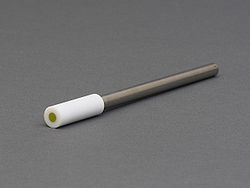
Working electrode
Encyclopedia

Electrode
An electrode is an electrical conductor used to make contact with a nonmetallic part of a circuit...
in an electrochemical system on which the reaction of interest is occurring. The working electrode is often used in conjunction with an auxiliary electrode
Auxiliary electrode
The Auxiliary electrode, often also called the counter electrode, is an electrode used in a three electrode electrochemical cell for voltammetric analysis or other reactions in which an electrical current is expected to flow...
, and a reference electrode
Reference electrode
A reference electrode is an electrode which has a stable and well-known electrode potential. The high stability of the electrode potential is usually reached by employing a redox system with constant concentrations of each participants of the redox reaction.There are many ways reference...
in a three electrode system
Voltammetry
Voltammetry is a category of electroanalytical methods used in analytical chemistry and various industrial processes. In voltammetry, information about an analyte is obtained by measuring the current as the potential is varied.- Three electrode system :...
. Depending on whether the reaction on the electrode is a reduction or an oxidation, the working electrode can be referred to as either cathodic
Cathode
A cathode is an electrode through which electric current flows out of a polarized electrical device. Mnemonic: CCD .Cathode polarity is not always negative...
or anodic
Anode
An anode is an electrode through which electric current flows into a polarized electrical device. Mnemonic: ACID ....
. Common working electrodes can consist of inert metals such as gold
Gold
Gold is a chemical element with the symbol Au and an atomic number of 79. Gold is a dense, soft, shiny, malleable and ductile metal. Pure gold has a bright yellow color and luster traditionally considered attractive, which it maintains without oxidizing in air or water. Chemically, gold is a...
, silver
Silver
Silver is a metallic chemical element with the chemical symbol Ag and atomic number 47. A soft, white, lustrous transition metal, it has the highest electrical conductivity of any element and the highest thermal conductivity of any metal...
or platinum
Platinum
Platinum is a chemical element with the chemical symbol Pt and an atomic number of 78. Its name is derived from the Spanish term platina del Pinto, which is literally translated into "little silver of the Pinto River." It is a dense, malleable, ductile, precious, gray-white transition metal...
, to inert carbon such as glassy carbon
Glassy carbon
Glassy carbon, also called vitreous carbon, is a non-graphitizing carbon which combines glassy and ceramic properties with those of graphite. The most important properties are high temperature resistance, hardness , low density, low electrical resistance, low friction, low thermal resistance,...
or pyrolytic carbon
Pyrolytic carbon
Pyrolytic carbon is a material similar to graphite, but with some covalent bonding between its graphene sheets as a result of imperfections in its production....
, and mercury
Mercury (element)
Mercury is a chemical element with the symbol Hg and atomic number 80. It is also known as quicksilver or hydrargyrum...
drop and film electrodes.
Special types of working electrodes
- UltramicroelectrodeUltramicroelectrodeAn Ultramicroelectrode is a working electrode used in a three electrode system. The small size of UME give them relatively large diffusion layers and small overall currents. These features allow UME to achieve useful steady-state conditions and very high scan rates with limited distortion...
(UME) - Rotating disk electrodeRotating disk electrodeA rotating disk electrode is a hydrodynamic working electrode used in a three electrode system. The electrode rotates during experiments inducing a flux of analyte to the electrode. These working electrodes are used in electrochemical studies when investigating reaction mechanisms related to...
(RDE) - Rotating ring-disk electrodeRotating ring-disk electrodeA rotating ring-disk electrode is double working electrode used in hydrodynamic voltammetry, very similar to a rotating disk electrode . The electrode actually rotates during experiments inducing a flux of analyte to the electrode...
(RRDE) - Hanging mercury drop electrodeHanging mercury drop electrodeThe hanging mercury drop electrode is a working electrode variation on the dropping mercury electrode . Experiments run with dropping mercury electrodes are referred to as forms of polarography...
(HMDE) - Dropping mercury electrodeDropping mercury electrodeThe dropping mercury electrode is a working electrode made of mercury and used in polarography. Experiments run with mercury electrodes are referred to as forms of polarography even if the experiments are identical or very similar to a corresponding voltammetry experiment which use solid working...
(DME)
See also
- Reference electrodeReference electrodeA reference electrode is an electrode which has a stable and well-known electrode potential. The high stability of the electrode potential is usually reached by employing a redox system with constant concentrations of each participants of the redox reaction.There are many ways reference...
- Auxiliary electrodeAuxiliary electrodeThe Auxiliary electrode, often also called the counter electrode, is an electrode used in a three electrode electrochemical cell for voltammetric analysis or other reactions in which an electrical current is expected to flow...
- Electrochemical cellElectrochemical cellAn electrochemical cell is a device capable of either deriving electrical energy from chemical reactions, or facilitating chemical reactions through the introduction of electrical energy. A common example of an electrochemical cell is a standard 1.5-volt "battery"...
- ElectrochemistryElectrochemistryElectrochemistry is a branch of chemistry that studies chemical reactions which take place in a solution at the interface of an electron conductor and an ionic conductor , and which involve electron transfer between the electrode and the electrolyte or species in solution.If a chemical reaction is...
- Electrode potentialElectrode potentialElectrode potential, E, in electrochemistry, according to an IUPAC definition, is the electromotive force of a cell built of two electrodes:* on the left-hand side is the standard hydrogen electrode, and...
- VoltammetryVoltammetryVoltammetry is a category of electroanalytical methods used in analytical chemistry and various industrial processes. In voltammetry, information about an analyte is obtained by measuring the current as the potential is varied.- Three electrode system :...
External links
- http://www.drhuang.com/science/chemistry/electrochemistry/polar.doc.htm
- http://www.gamry.com/App_Notes/Potentiostat_Primer.htm
- http://www.iupac.org/goldbook/W06686.pdf
- http://new.ametek.com/content-manager/files/PAR/App%20Note%20E-4%20-%20Electrochemical%20Analysis%20Techniques1.pdf

